JAJSCG6 September 2016 TPL5010-Q1
PRODUCTION DATA.
- 1 特長
- 2 アプリケーション
- 3 概要
- 4 改訂履歴
- 5 デバイス比較表
- 6 Pin Configuration and Functions
- 7 Specifications
- 8 Detailed Description
- 9 Application and Implementation
- 10Power Supply Recommendations
- 11Layout
- 12デバイスおよびドキュメントのサポート
- 13メカニカル、パッケージ、および注文情報
7 Specifications
7.1 Absolute Maximum Ratings
over operating free-air temperature range (unless otherwise noted)(1)| MIN | MAX | UNIT | ||
|---|---|---|---|---|
| Supply voltage (VDD-GND) | –0.3 | 6.0 | V | |
| Input voltage at any pin(3) | –0.3 | VDD + 0.3 | V | |
| Input current on any pin | –5 | 5 | mA | |
| Tstg | Storage temperature | –65 | 150 | °C |
| TJ | Junction temperature(2) | 150 | °C | |
(1) Stresses beyond those listed under Absolute Maximum Ratings may cause permanent damage to the device. These are stress ratings only, which do not imply functional operation of the device at these or any other conditions beyond those indicated under Recommended Operating Conditions. Exposure to absolute-maximum-rated conditions for extended periods may affect device reliability.
(2) The maximum power dissipation is a function of TJ(MAX), θJA, and the ambient temperature, TA. The maximum allowable power dissipation at any ambient temperature is PDMAX = (TJ(MAX) - TA)/ θJA. All numbers apply for packages soldered directly onto a PC board.
(3) The voltage between any two pins should not exceed 6V.
7.2 ESD Ratings
| VALUE | UNIT | |||
|---|---|---|---|---|
| V(ESD) | Electrostatic discharge | Human-body model, per AEC Q100-002(1) | ±2000 | V |
| Charged-device model (CDM), per AEC Q10-011 | ±750 | |||
(1) AEC Q100-002 indicates that HBM stressing shall be in accordance with ANSI/ESDA/JEDEC JS-001 specification.
7.3 Recommended Operating Conditions
over operating free-air temperature range (unless otherwise noted)| MIN | NOM | MAX | UNIT | ||
|---|---|---|---|---|---|
| Supply voltage (VDD-GND) | 1.8 | 5.5 | V | ||
| Temperature | –40 | 125 | °C | ||
7.4 Thermal Information
| THERMAL METRIC(1) | TPL5010-Q1 | UNIT | |
|---|---|---|---|
| SOT23 | |||
| 6 PINS | |||
| RθJA | Junction-to-ambient thermal resistance | 163 | °C/W |
| RθJC(top) | Junction-to-case (top) thermal resistance | 26 | °C/W |
| RθJB | Junction-to-board thermal resistance | 57 | °C/W |
| ψJT | Junction-to-top characterization parameter | 7.5 | °C/W |
| ψJB | Junction-to-board characterization parameter | 57 | °C/W |
(1) For more information about traditional and new thermal metrics, see the Semiconductor and IC Package Thermal Metrics application report.
7.5 Electrical Characteristics
TA= 25°C, VDD-GND=2.5 V (unless otherwise stated)(1)| PARAMETER | TEST CONDITIONS | MIN(2) | TYP(3) | MAX(2) | UNIT | ||
|---|---|---|---|---|---|---|---|
| POWER SUPPLY | |||||||
| IDD | Supply current(4) | Operation mode | 35 | 50 | nA | ||
| Digital conversion of external resistance (Rext) | 200 | 400 | µA | ||||
| TIMER | |||||||
| tIP | Time interval period(5) | 1650 selectable time Intervals | Min time interval | 100 | ms | ||
| Max time interval | 7200 | s | |||||
| Time interval setting accuracy(7) | Excluding the precision of Rext | ±0.6% | |||||
| Timer interval setting accuracy over supply voltage | 1.8 V ≤ VDD ≤ 5.5 V | ±25 | ppm/V | ||||
| tOSC | Oscillator accuracy | –0.5% | 0.5% | ||||
| Oscillator accuracy over temperature(5) | -40°C ≤ TA ≤ 125°C | 150 | ppm/°C | ||||
| Oscillator accuracy over supply voltage(5) | 1.8 V ≤ VDD ≤ 5.5 V | ±0.4 | %/V | ||||
| Oscillator accuracy over life time(6) | 0.24% | ||||||
| tDONE | Minimum DONE pulse width (5) | 100 | ns | ||||
| tRSTn | RSTn pulse width | 320 | ms | ||||
| tWAKE | WAKE pulse width | 20 | ms | ||||
| t_Rext | Time to convert Rext(5) | 100 | ms | ||||
| DIGITAL LOGIC LEVELS | |||||||
| VIH | Minimum logic high threshold DONE pin | 0.7 × VDD | V | ||||
| VIL | Maximum logic low threshold DONE pin | 0.3 × VDD | V | ||||
| VOH | Logic output high-level WAKE pin | Iout = 100 µA | VDD – 0.3 | V | |||
| Iout = 1 mA | VDD – 0.7 | V | |||||
| VOL | Logic output low-level WAKE pin | Iout = –100 µA | 0.3 | V | |||
| Iout = –1 mA | 0.7 | V | |||||
| VOLRSTn | RSTn logic output low-level | IOL= –1 mA | 0.3 | V | |||
| IOHRSTn | RSTn high-level output current | VOHRSTn = VDD | 1 | nA | |||
| VIHM_RST | Minimum logic high threshold DELAY/M_RST pin(5) | 1.5 | V | ||||
(1) Values apply only for factory testing conditions at the temperature indicated. Factory testing conditions result in very limited self-heating of the device such that TJ = TA. No specification of parametric performance is indicated in the electrical tables under conditions of internal self-heating where TJ > TA. Absolute Maximum Ratings indicate junction temperature limits beyond which the device may be permanently degraded, either mechanically or electrically.
(2) Limits are specified by testing, design, or statistical analysis at 25°C. Limits over the operating temperature range are specified through correlations using statistical quality control (SQC) method.
(3) Typical values represent the most likely parametric norm as determined at the time of characterization. Actual typical values may vary over time and will also depend on the application and configuration. The typical values are not tested and are not specified on shipped production material.
(4) The supply current excludes load and pull-up resistor current. Input pins are at GND or VDD.
(5) This parameter is specified by design and/or characterization and is not tested in production.
(6) Operational life time test procedure equivalent to 10 years.
(7) The accuracy for time interval settings below 1 second is ±100 ms.
7.6 Timing Requirements
| MIN(3) | NOM(4) | MAX(3) | UNIT | ||||
|---|---|---|---|---|---|---|---|
| trRSTn | Rise Time RSTn (2) | Capacitive load 50 pF, Rpull-up 100 kΩ | 11 | µs | |||
| tfRSTn | Fall time RSTn (2) | Capacitive load 50 pF, Rpull-up 100 kΩ | 50 | ns | |||
| trWAKE | Rise time WAKE (2) | Capacitive load 50 pF | 50 | ns | |||
| tfWAKE | Fall time WAKE (2) | Capacitive load 50 pF | 50 | ns | |||
| tDDONE | DONE to RSTn or WAKE to DONE delay | Min delay(1) | 100 | ns | |||
| Max delay (1) | tIP–20 | ms | |||||
| tM_RST | Minimum valid manual reset (2) | Observation time 30 ms | 20 | ms | |||
| tDB | De-bounce manual reset | 20 | ms | ||||
(1) In case of RSTn from its falling edge, in case of WAKE, from its rising edge.
(2) This parameter is specified by design and/or characterization and is not tested in production.
(3) Limits are specified by testing, design, or statistical analysis at 25°C. Limits over the operating temperature range are specified through correlations using statistical quality control (SQC) method.
(4) Typical values represent the most likely parametric norm as determined at the time of characterization. Actual typical values may vary over time and will also depend on the application and configuration. The typical values are not tested and are not specified on shipped production material.
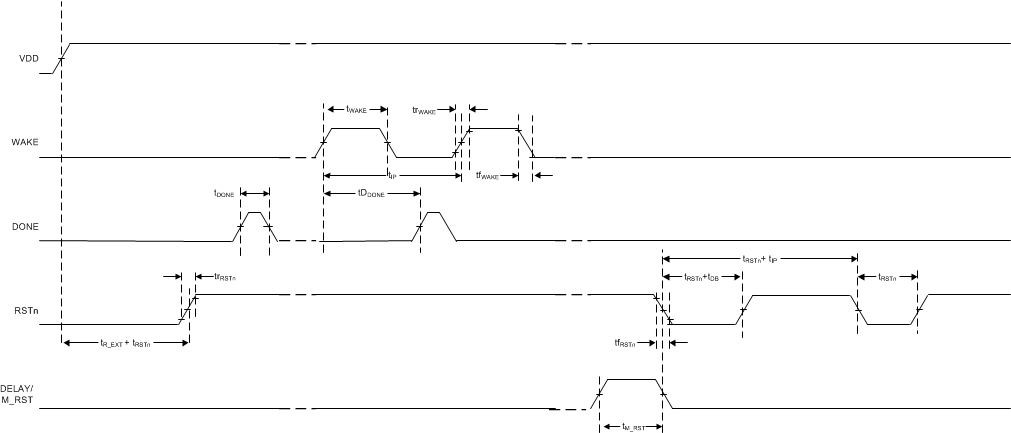 Figure 1. TPL5010-Q1 Timing
Figure 1. TPL5010-Q1 Timing
7.7 Typical Characteristics
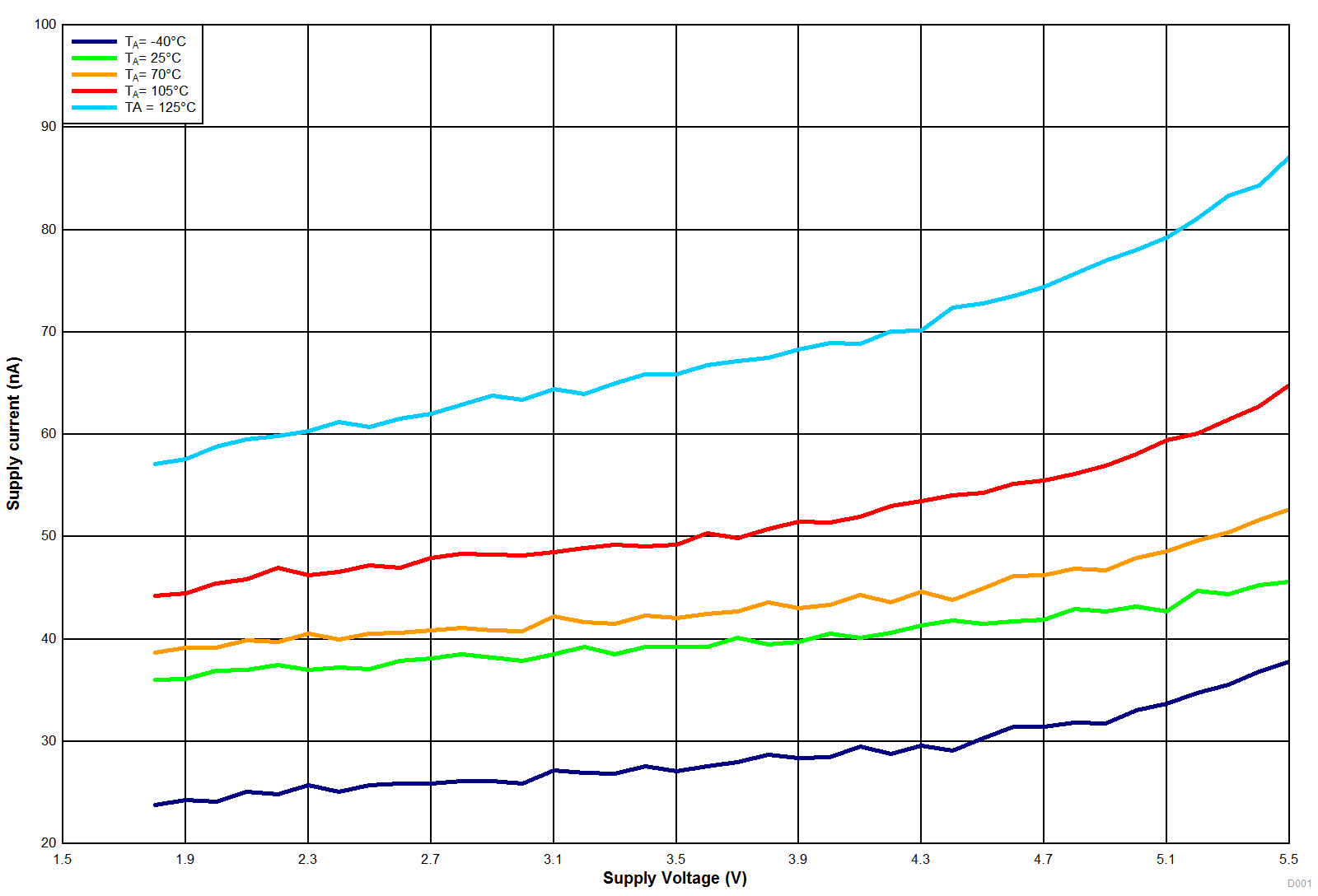
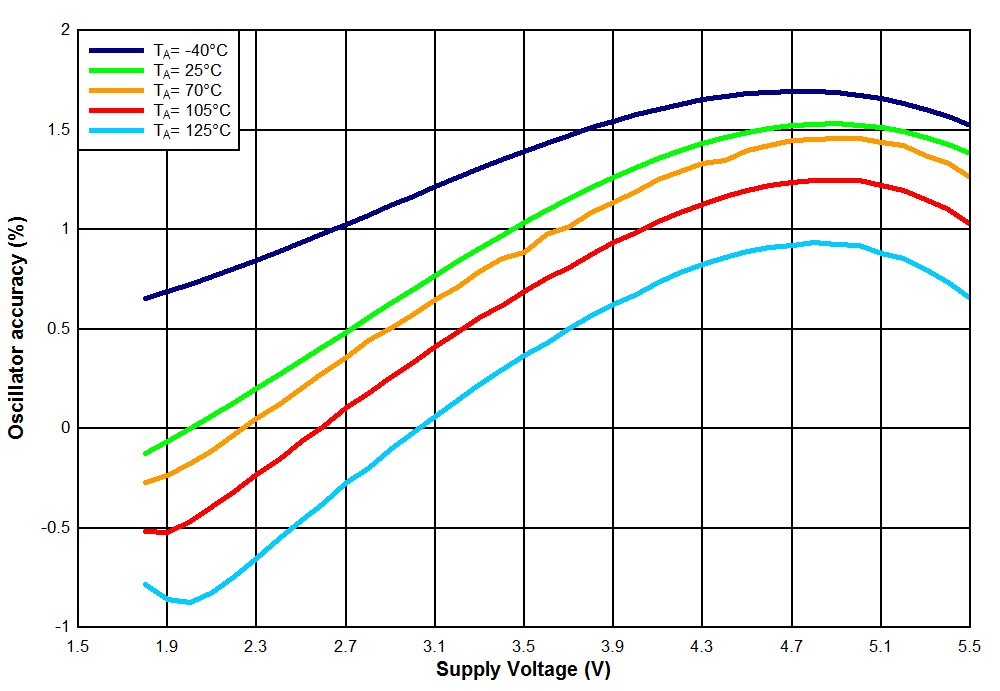
1.
Figure 4. Oscillator Accuracy vs VDD
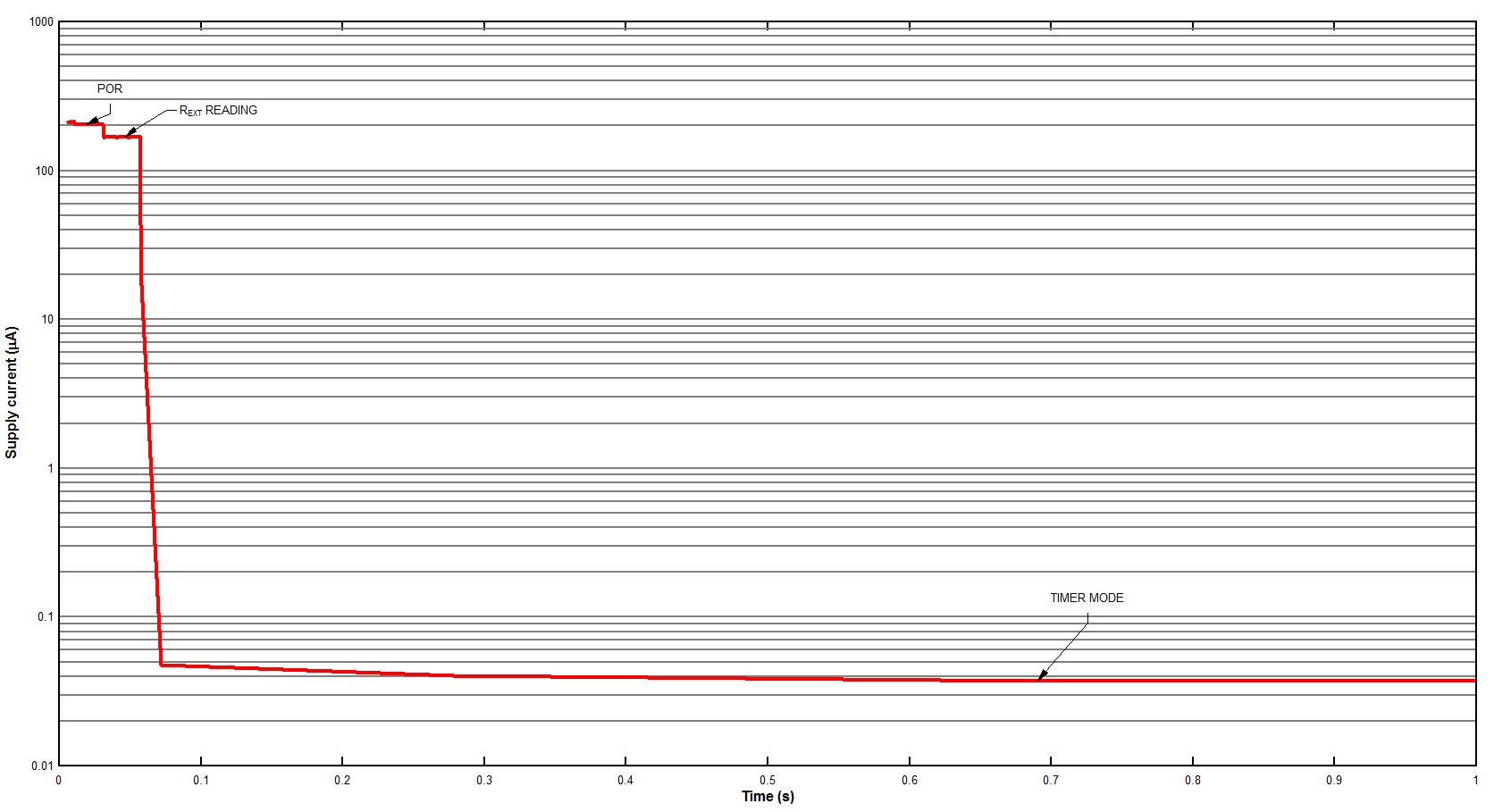
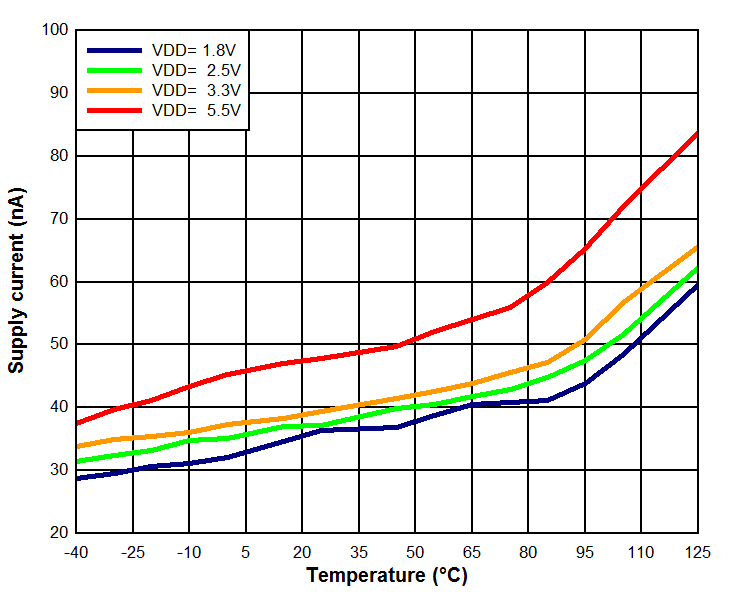
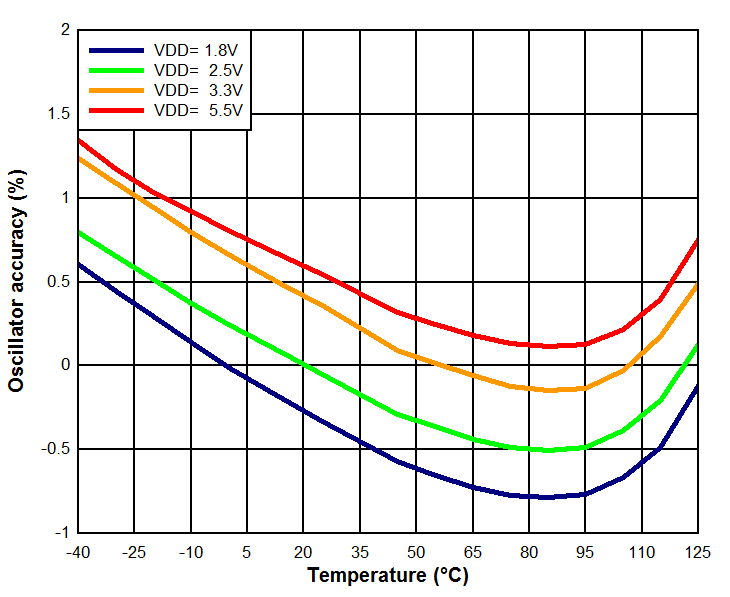
1.
Figure 5. Oscillator Accuracy vs Temperature
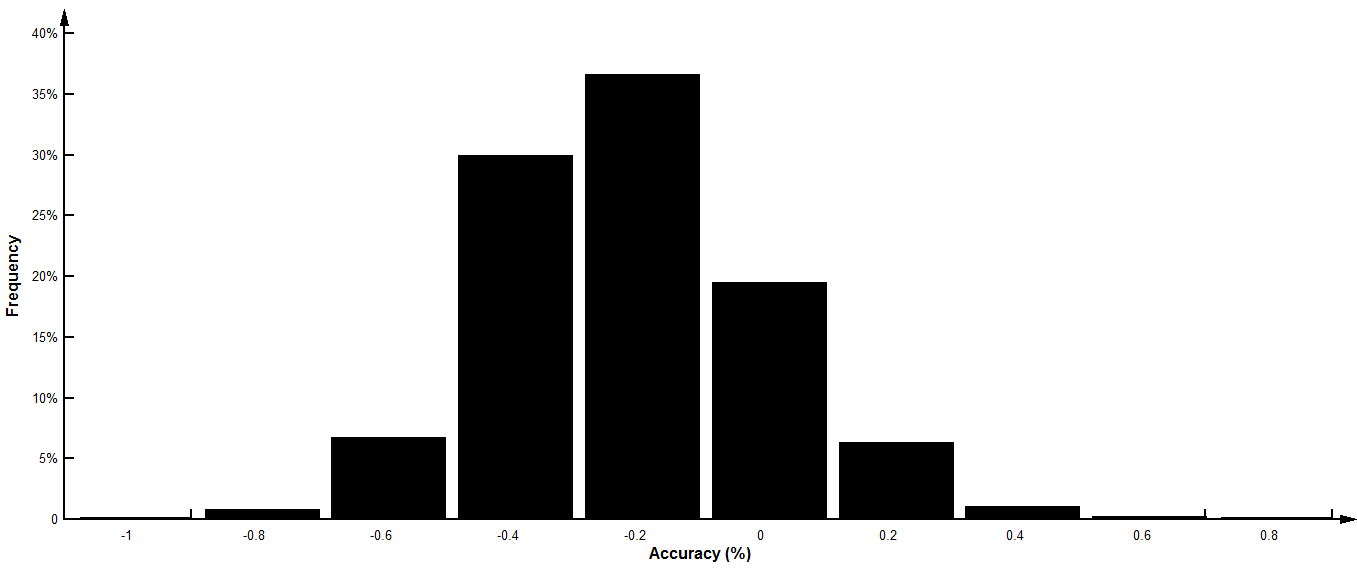
| number of observations > 20000 | 1 s < tIP ≤ 7200 s | |